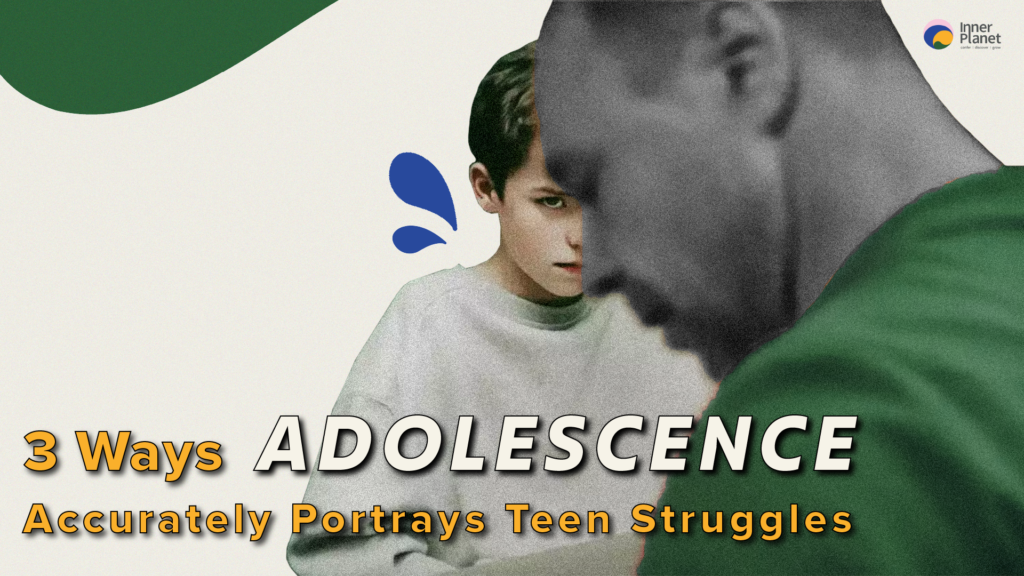It’s not always clear what unfolds behind the glow of a teenager’s screen. In the British series Adolescence (2025), a quiet suburban setting becomes the backdrop for escalating emotional turmoil—a group chat gone wrong, a private photo leaked, friendships turning subtly cruel, and stark loneliness—bubbling with the invisible tension of being young in a hyperconnected world.
Let’s explore how social media, peer dynamics, and silence shape the inner lives of adolescents today. Like the show itself, let’s try this in one long take.
The Storm Within
Before the world demands resilience from teenagers, it rarely stops to ask if they’ve had the chance to build it.
Today’s teens live in a world where everything is visible, immediate, and overwhelming. Every crisis, every injustice, every achievement—local or global—arrives unfiltered on their screens, often without context or emotional tools to process it. They know more than ever before, but knowing doesn’t translate well to coping.
At the same time, teenagers are navigating a uniquely personal storm: hormonal shifts, surging self-awareness, a growing body that often feels unfamiliar, and a mind that’s only beginning to understand the weight of choices. Identity is still forming, friendships are fragile, and everything feels like it matters too much—or not at all.
And yet, life doesn’t pause. Schools assign grades. Social platforms assign value. Parents assign expectations. The world moves, and they’re expected to move with it—ready or not.
One of the crueller aspects of growing up is that the adults who once walked this road often forget how rocky it really was. It’s easy to dismiss teen emotions as drama, their indecision as laziness, their insecurity as superficial, and their rebellion as defiance. But those reactions often come from confusion—from a body that feels foreign, and a brain still learning how to balance urgency and uncertainty.
Empathy means remembering what we’ve survived, not minimising those still going through it.
- What’s Happening Behind That Screen?
In one of Adolescence’s most haunting arcs, a group chat slowly morphs into a tool of exclusion and bullying. No adult intervenes. No adult even notices.
This mirrors the world many teenagers navigate—one where boundaries are fluid, and actions taken online can spiral in ways they may not fully grasp. A study from India found that nearly 30% of adolescents displayed signs of Body Dysmorphic Disorder (BDD)—a mental health condition where individuals become obsessively preoccupied with perceived flaws in their appearance, often invisible to others. These symptoms were linked to beauty filters, excessive selfie culture, and constant comparison (Khajuria et al., 2025).
For many, especially girls and teens from less privileged backgrounds, validation now often comes through likes and curated images. And yet, these behaviours aren’t inherently vain or shallow—they’re learned responses in a world that teaches young people, sometimes relentlessly, that how they look is more important than how they feel.
- The Joke That Goes Too Far
In Adolescence, a private photo is leaked. What follows is subtle—whispers, stares, silence. But its impact is severe. The cruelty isn’t obviously loud. It doesn’t need to be.
While the show captures the emotional devastation, it also hints at something deeper: a culture where jokes blur into humiliation, and where peer validation sometimes trumps empathy. Research from India connects this kind of online shaming to increased suicidal ideation (Gupta & Basera, 2021). The World Health Organization highlights the concerning reality, citing suicide as the fourth leading cause of death among teens globally.
But what stands out in these stories isn’t just the pain—it’s how alone young people often are in that pain. What might seem like “just a joke” to one teen can be a tipping point for another. And without adult understanding, these moments often go unspoken, unresolved.
- A Loneliness That Looks Like Scrolling
There’s a storyline in Adolescence where a girl begins to drift. Mounting absence. From chats, from meals, from herself. She scrolls more, engages less.
This reflects real patterns. Longitudinal studies in India show that teens who use social media excessively report higher rates of depressive symptoms, especially when it displaces real connection (Maurya et al., 2024). Girls often bear the brunt, caught in loops of comparison and emotional isolation.
But boys aren’t spared either. One of the most tragic turns in Adolescence is a boy murdering his classmate. The act is horrifying. But it’s also the result of something festering. The character isn’t just “a bad kid”—he’s a vessel for everything gone wrong: toxic online influence, unchecked peer dynamics, masculinity as aggression, and a total absence of emotional literacy.
This isn’t to excuse his actions. But it is to say: if we only see monsters, we’ll miss the warning signs. And we’ll keep letting boys fall through the cracks until they hurt others, and themselves.
What Adolescence Didn’t Show
The series holds up a mirror, but there are parts of the picture left unexplored—like how family structures, school environments, and broader cultural forces shape adolescent outcomes.
Research fills that gap. According to Lin and Guo (2024), mental health risks stem from a tangle of influences—self-esteem, parenting styles, academic pressure, peer relationships, and yes, social media. In India, these factors often collide with additional stressors: academic pressure, a silence around therapy, rigid expectations, and stigma that discourages vulnerability.
It’s not about blaming any one app, parent, or teacher. It’s about recognising that every teen’s mental health is a puzzle with many pieces—and we often only see the corner of it.
Listening Without Diagnosing
One of Adolescence’s strengths is its restraint. It doesn’t explain away feelings—it shows them. Fragmented, raw, real. And maybe that’s the most valuable thing we can take from it.
The WHO reminds us that half of all mental health conditions begin before age 14, yet most remain unrecognised. Not every sign needs analysis—but many need attention.
Look for:
- Shifts in sleep, appetite, or energy
- Withdrawal from hobbies or friends
- Sudden changes in online behaviour
- Irritability that masks sadness
Support doesn’t always mean intervention. Sometimes it just means asking without assumptions. Listening without labelling.
Adolescence doesn’t offer redemption arcs. It offers reflection. And in doing so, it asks something of us—not to simply “fix” everything, but to see better.
Because if there’s one thing the research confirms, it’s this: pain doesn’t always announce itself. It whispers. It hides behind laughter, grades, and endless scrolling.
And if we want to help, we don’t need to shout. We need to show up—and stay. The world may not stop for teens, but we can.
Recall what it felt like to be a teen, and extend the empathy that would’ve nurtured you in those trying times. And if you’re someone who needs help, we’re always just a call away!
References
- Chang, K., & Kuhlman, K. R. (2022). Adolescent-onset depression is associated with altered social functioning into middle adulthood. Scientific Reports, 12, 17320. https://doi.org/10.1038/s41598-022-22131-1
- Clayborne, Z. M., Varin, M., & Colman, I. (2018). Adolescent depression and long-term psychosocial outcomes: A systematic review and meta-analysis. Journal of the American Academy of Child & Adolescent Psychiatry. https://doi.org/10.1016/j.jaac.2018.07.896
- Gupta, S., & Basera, D. (2021). Youth suicide in India: A critical review and implication for the national suicide prevention policy. OMEGA – Journal of Death and Dying, 88(1), 245–273. https://doi.org/10.1177/00302228211045169
- Johnson, D., Dupuis, G., Piche, J., Clayborne, Z., & Colman, I. (2018). Adult mental health outcomes of adolescent depression: A systematic review. Depression and Anxiety, 35(8), 700–716. https://doi.org/10.1002/da.22777
- Khajuria, A., Gandotra, A., Khajuria, A., Arora, K., Gupta, R. K., Gupta, U., & Babber, S. (2025). Role of social media in the rising body dissatisfaction and dysmorphia among adolescents. Cureus, 17(1), e78314. https://doi.org/10.7759/cureus.78314
- Lin, J., & Guo, W. (2024). The research on risk factors for adolescents’ mental health. Behavioral Sciences, 14(4), 263. https://doi.org/10.3390/bs14040263
- Maurya, C., Dhillon, P., Sharma, H., et al. (2024). Bidirectional and cross-lag relationship between social media use and psychological wellbeing: Evidence from an Indian adolescent cohort study. BMC Public Health, 24, 303. https://doi.org/10.1186/s12889-023-17276-1
- McGorry, P., Gunasiri, H., Mei, C., Rice, S., & Gao, C. X. (2025). The youth mental health crisis: Analysis and solutions. Frontiers in Psychiatry, 15, 1517533. https://doi.org/10.3389/fpsyt.2024.1517533
- Rajkumar, E., Julia, G., Sri Lakshmi, K., N. V., et al. (2022). Prevalence of mental health problems among rural adolescents in India: A systematic review and meta-analysis. Scientific Reports, 12, 16573. https://doi.org/10.1038/s41598-022-19731-2
- Steare, T., Gutiérrez Muñoz, C., Sullivan, A., & Lewis, G. (2023). The association between academic pressure and adolescent mental health problems: A systematic review. Journal of Affective Disorders, 339, 302–317. https://doi.org/10.1016/j.jad.2023.07.028
- Taddi, V. V., Kohli, R. K., & Puri, P. (2024). Perception, use of social media, and its impact on the mental health of Indian adolescents: A qualitative study. World Journal of Clinical Pediatrics, 13(3), 97501. https://doi.org/10.5409/wjcp.v13.i3.97501
- World Health Organization. (2023). Adolescent mental health. https://www.who.int/news-room/fact-sheets/detail/adolescent-mental-health


